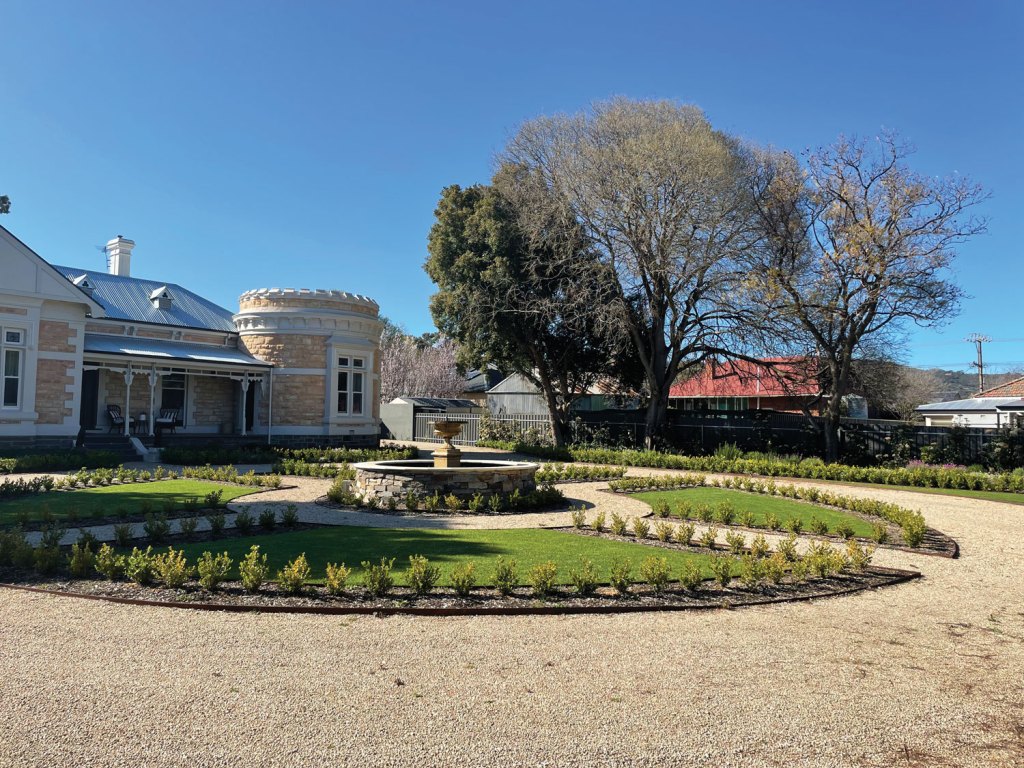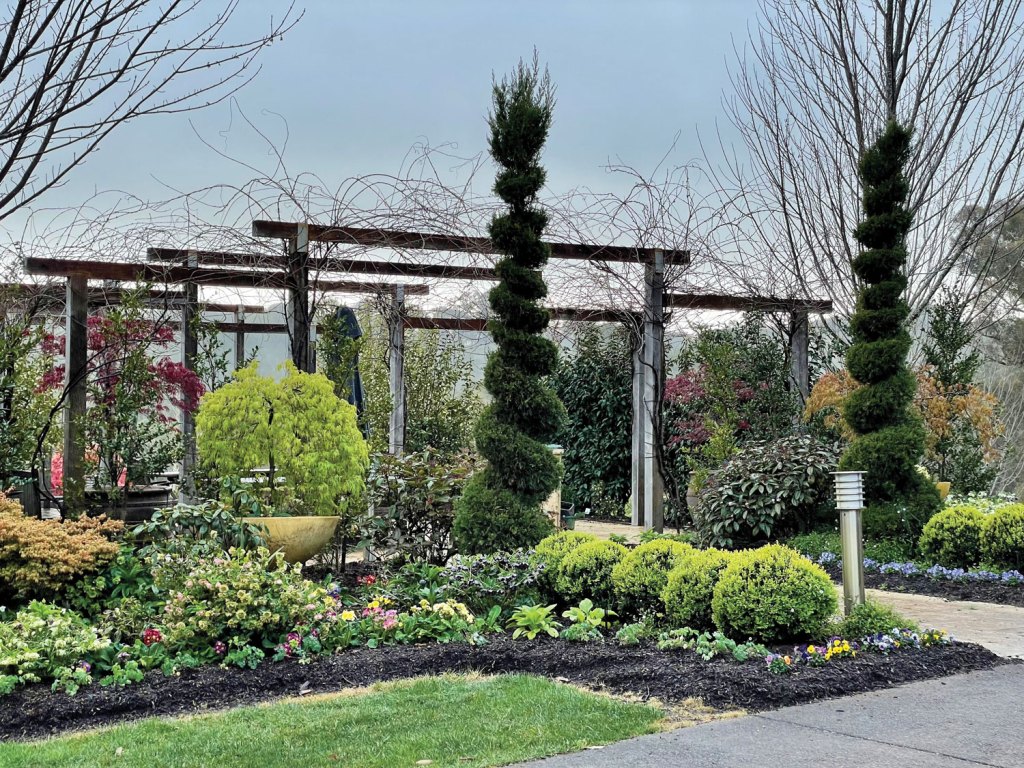The key to a successfully designed garden is playing the long game – implementing a plan that will see the garden grow beautifully not only over weeks and months, but years and even decades.
Dream gardens are visual delights – vibrant blooms, lush greenery, and inviting spaces to relax. But how do you bring your vision to life in a way that not only looks beautiful today, but continues to thrive for years to come? This is where the principles of garden design and landscape architecture are integral. A well-planned garden isn’t just about aesthetics; it’s about creating a space that matures gracefully, adapts to seasonal changes, and requires minimal maintenance over time.
In South Australia, where the climate ranges from Mediterranean in coastal regions to semi-arid in the interior – with unpredictable rainfall – thoughtful garden planning is essential. One of the most important aspects of successful garden design is planning for growth, envisioning how a garden will look in five, 10, or even 20 years. Plants are not static elements; they change in shape, size, and structure as they mature. Without careful consideration, a tree planted for shade today may soon dominate a space or interfere with pathways and structures, while shrubs and groundcovers may outgrow their intended areas, creating an overgrown or imbalanced landscape.
A strong foundation is key to ensuring a garden remains functional and visually harmonious as it evolves. Creating a master plan is an effective way to map out the layout of spaces and functions, ensuring that pathways, courtyards, lawn spaces and relaxation areas are positioned thoughtfully within the design. This framework helps establish a sense of flow and usability while providing a guide for future growth. From there, a planting plan can be developed, considering key plant characteristics such as height, size, shape and colour. A well-balanced planting scheme ensures that taller trees provide structure and shade without overwhelming a space, medium-sized shrubs contribute texture and greenery, and low-growing groundcovers fill gaps while helping to suppress weeds. By taking a layered approach to plant selection, gardens maintain depth, balance, and longevity as they mature.

For South Australian gardens, choosing drought-tolerant and climate-adapted species ensures long-term success with minimal water use. Feature trees such as jacaranda or native bottle trees (Brachychiton rupestris) develop striking beauty over decades, while hardy shrubs such as westringia and correa provide year-round greenery with minimal upkeep. Groundcovers including native grasses and kangaroo paw (Anigozanthos) add texture and colour without requiring excessive maintenance. Selecting the right plants for a site’s soil, microclimate and long-term growth habits ensures the garden remains resilient and cohesive over time.
Beyond choosing the right plants, it’s important to design a garden that aligns with your lifestyle. A beautifully manicured hedge of buxus can frame a formal garden elegantly, but it requires regular pruning to maintain its structure. Likewise, expansive garden beds filled with seasonal flowers demand frequent care to stay at their best. If time is limited, opting for lower-maintenance plants, structural evergreens and self-sufficient native species can reduce upkeep while still achieving a lush and considered design. A garden should be a place to enjoy, not a burden – balancing aesthetics with the level of care you’re willing and able to provide, ensures a sustainable and enjoyable outdoor space.

This is where the expertise of a landscape architect, or garden designer becomes invaluable. Beyond aesthetics, a designer considers how plants will interact, ensuring they have adequate space to grow, reducing future maintenance burdens, and creating a garden that remains visually balanced as it matures. Without this foresight, homeowners may face the challenge of overcrowded plantings, excessive pruning, or struggling vegetation that isn’t suited to South Australia’s conditions.
For those who prefer a DIY approach, researching plant growth habits before purchasing is essential. A plant that looks perfect in a nursery pot may quickly outgrow its space or require more maintenance than anticipated. Visiting a local garden centre is a great starting point, as knowledgeable staff can offer recommendations tailored to the specific conditions of your area. Observing established gardens in the neighbourhood can also provide valuable insight into what thrives locally. By choosing climate-appropriate species, grouping plants with similar water needs, and allowing space for natural growth, even a self-designed garden can achieve lasting beauty and functionality.
South Australia’s climate features distinct seasons – scorching summers, cool and wet winters, and bursts of colour in spring and autumn. Planning for and working with these seasonal transitions is essential. Staggering blooming periods and incorporating a mix of evergreen and deciduous plants ensures continuous visual interest throughout the year.
Spring brings an explosion of colour with plants such as kangaroo paw, hardenbergia, wisteria, cherry blossom and rhododendron providing vibrant flowers. As summer sets in, hardy native survivors such as willow myrtle (Agonis flexuosa), saltbush (Atriplex nummularia), and flowering gum (Corymbia ficifolia) thrive in the heat, alongside timeless favourites such as lavender, rosemary and bougainvillea.

Subscribe for updates

Autumn welcomes striking seasonal changes, with the warm hues of ornamental grasses and foliage plants such as Japanese maples (Acer palmatum), fraxinus and lagerstroemia varieties bringing depth and movement to the landscape. With great planning, even winter gardens can remain lively with beautiful flowering shrubs such as camellias, hellebores, hakeas and grevilleas –
all of which add texture, structure and seasonal colour.
Incorporating evergreen plants ensures the garden maintains form and greenery even in the driest months. Plants including olive trees and lomandra varieties are perfect choices for this purpose. At the same time, deciduous trees and shrubs bring dynamic seasonal interest, offering shade in summer and allowing light through in winter. Gleditsia triacanthos, Pistacia chinensis and Pyrus calleryana provide stunning autumn foliage before their branches sculpt the winter landscape.
By thoughtfully planning for seasonal changes, gardens not only stay attractive, but also require less intensive maintenance.

A well-designed garden should not demand excessive upkeep. Choosing climate-appropriate plants and implementing efficient irrigation methods significantly reduce maintenance efforts. Drought-tolerant species and native selections minimise the need for supplementary watering and regular mulching is a key practice every gardener should implement. It conserves moisture, suppresses weeds and enriches the soil as it decomposes. Organic mulches such as bark or pea straw enhance soil health while complementing the natural aesthetic of the garden.
One of the most rewarding aspects of garden design is witnessing the transformation over time. A sapling evolving into a shade tree, a small shrub expanding into a floral display—these changes contribute to a garden’s character and charm. Just like us, gardens are dynamic spaces that evolve with the seasons and years. Thoughtful planning and plant selection ensure they remain visually stunning, functional, and sustainable.
Whether you’re designing your garden independently or working with a professional, taking the time to consider growth, maintenance, and seasonal changes will result in a space that thrives for years to come. And if you’re unsure where to start, visiting a local garden centre can offer valuable insights into plant selection and care, helping you create a garden that not only looks good today but continues to flourish well into the future.
This article first appeared in the Winter 2025 issue of SALIFE Gardens & Outdoor Living magazine.





